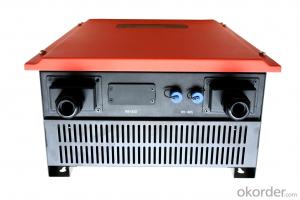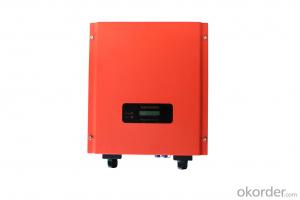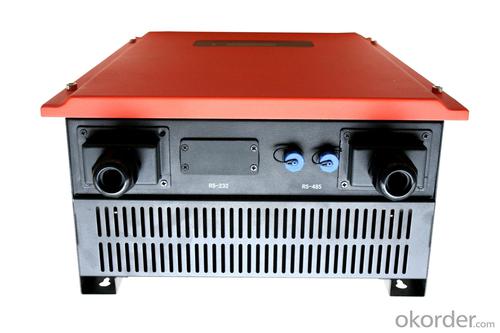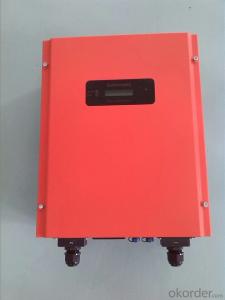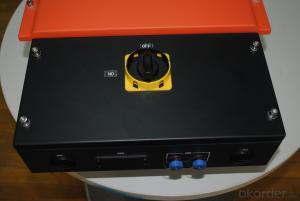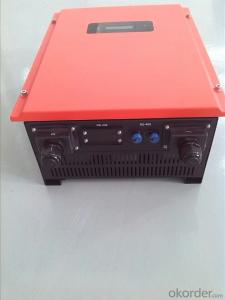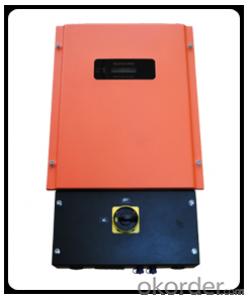100kW Solar Inverter Sunteams 4000-5000(US) ETL
- Loading Port:
- Shanghai
- Payment Terms:
- TT OR LC
- Min Order Qty:
- 5 watt
- Supply Capability:
- 3000 watt/month
OKorder Service Pledge
OKorder Financial Service
You Might Also Like
The Sunteams (US) 1500 ~5000 series isapplicable to various rooftops and small scale photovoltaic grid connected power plants. Their nominal output powers are 1.5 kW, 2 kW, 2.5 kW, 3 kW, 4 kW and 5kW respectivelywith Certificate ETL (220V/60HZ).
This series is transformerless and has a wide range of MPPT input voltage. Itsmaximum conversion efficiency and MPPT tracking accuracy reach 97.6 % and 99.5% respectively. The maximum DC voltage reaches 550 V. Its multilingualLCD display facilitates easy operation. It has waterproof direct plug interminals. It has overvoltage, islanding, short circuit, overloading andoverheating protection functions. Its IP65 protection degree will ensure itruns well in various tough environments.
These units are available with or without wirebox.
UL certified
■ For countries with UL certification (UL 1741 / IEEE 1547)
Efficient
■ The CEC efficiency of the inverter can reach 95.0 %-97.5 %
■ Transformerless desi
Simple
■ ‘Plug and play’connection for easy installation and maintenance
■ Designed for hanging with simple and easy installation
■ Fanless cooling concept
Communicative
■ RS232/RS485 interfaces as standard
■ Optional Bluetooth technology
- Q: What is the maximum temperature range for a solar inverter?
- The maximum temperature range for a solar inverter typically varies between -25°C to 60°C (-13°F to 140°F).
- Q: What is the role of Maximum Power Point Tracking (MPPT) in a solar inverter?
- The role of Maximum Power Point Tracking (MPPT) in a solar inverter is to optimize the power output from the solar panels by constantly adjusting the voltage and current to ensure that the solar panels are operating at their maximum power point. This allows the solar inverter to efficiently convert the DC power generated by the solar panels into AC power for use in homes or businesses. By tracking and adjusting the maximum power point, MPPT technology maximizes the overall energy production and improves the overall efficiency of the solar inverter system.
- Q: Can a solar inverter be integrated with energy management systems?
- Yes, a solar inverter can be integrated with energy management systems. Solar inverters can be connected to energy management systems to monitor and control the generation and consumption of solar energy. This integration allows for better optimization of energy usage, real-time monitoring of solar production, and intelligent management of energy flows within a building or grid.
- Q: How does a solar inverter handle grid synchronization during startup?
- A solar inverter handles grid synchronization during startup by employing advanced control algorithms. It continuously monitors the grid voltage and frequency, aligns itself with the grid parameters, and gradually increases its output power to match the grid. This synchronization process ensures that the solar inverter seamlessly integrates with the grid and provides stable and synchronized power generation.
- Q: How does a solar inverter handle power factor correction?
- A solar inverter handles power factor correction by converting the DC power generated by solar panels into AC power that is synchronized with the utility grid. It adjusts the phase and magnitude of the AC output to match the power factor requirements of the grid, ensuring efficient power transfer and reducing reactive power.
- Q: How is the output voltage of a solar inverter regulated?
- The output voltage of a solar inverter is regulated through the use of control circuitry and power electronics components. These components monitor the input voltage from the solar panels and adjust the output voltage to meet the desired specifications. The control circuitry ensures that the output voltage remains stable and within the required range, even when there are fluctuations in the input voltage or varying load conditions.
- Q: Are there any fire safety concerns associated with solar inverters?
- Yes, there are some fire safety concerns associated with solar inverters. While solar inverters themselves are not typically a fire hazard, there are a few potential risks to consider. Firstly, improper installation of the solar inverter can lead to electrical issues that may cause a fire. It is important to hire a qualified and certified professional to install the inverter, ensuring that all electrical connections are secure and up to code. Secondly, if the solar inverter is located in an area that is prone to high temperatures or excessive heat, there is a risk of overheating. Inverters generate heat as they convert the direct current (DC) from solar panels into alternating current (AC) for use in homes or businesses. If the inverter is not properly ventilated or if it is exposed to extreme heat, it can overheat and potentially start a fire. Additionally, if there is a fault in the inverter or if it is damaged, it can increase the risk of fire. Regular maintenance and inspection of the solar inverter can help identify any potential issues and ensure its safe operation. To mitigate these fire safety concerns, it is crucial to follow proper installation guidelines, regularly inspect and maintain the inverter, and ensure it is located in a well-ventilated area away from excessive heat sources. It is also advisable to have a fire extinguisher nearby and to have a fire safety plan in place in case of emergencies.
- Q: Can a solar inverter be used with a solar-powered water pump?
- Yes, a solar inverter can be used with a solar-powered water pump. A solar inverter converts the direct current (DC) generated by solar panels into alternating current (AC) that can be used to power various electrical devices, including water pumps. This allows the solar panels to directly power the water pump, making it an efficient and sustainable solution for water pumping applications.
- Q: What is the maximum output voltage of a solar inverter?
- The maximum output voltage of a solar inverter depends on its design and specifications. Generally, the maximum output voltage can range from 240 to 600 volts for residential inverters, and up to several thousand volts for commercial or utility-scale inverters.
- Q: What are the advantages of using a transformerless solar inverter?
- The advantages of using a transformerless solar inverter include increased efficiency, reduced size and weight, lower cost, and improved reliability. Due to the absence of a transformer, these inverters are more energy-efficient, resulting in higher electricity production from the solar panels. They also have a smaller form factor and weigh less, making them easier to install and transport. Transformerless inverters are typically cheaper to manufacture, leading to cost savings for consumers. Additionally, their simplified design without a bulky transformer reduces the likelihood of component failure, enhancing the overall reliability of the system.
Send your message to us
100kW Solar Inverter Sunteams 4000-5000(US) ETL
- Loading Port:
- Shanghai
- Payment Terms:
- TT OR LC
- Min Order Qty:
- 5 watt
- Supply Capability:
- 3000 watt/month
OKorder Service Pledge
OKorder Financial Service
Similar products
Hot products
Hot Searches
Related keywords
